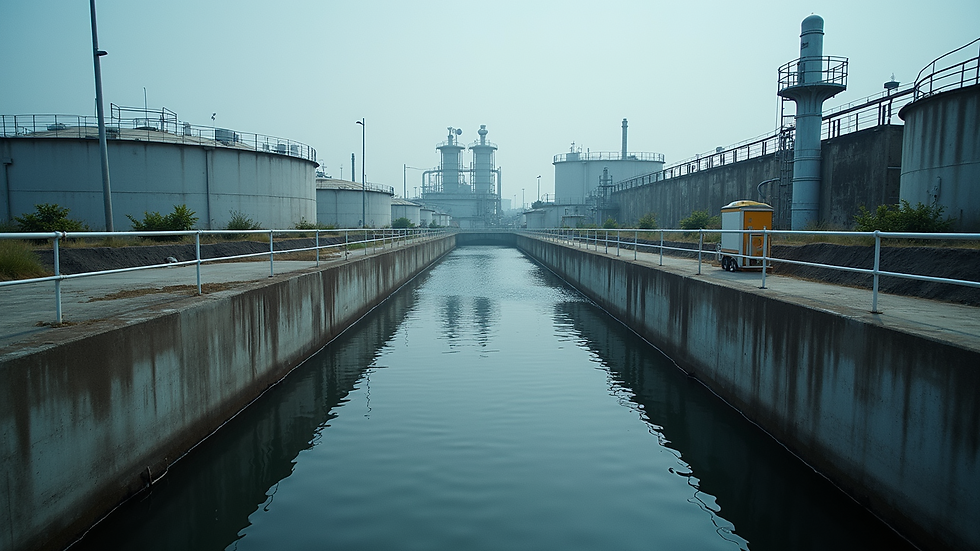Innovative Solutions for Industrial Wastewater
- palwinder kaur
- Sep 15
- 4 min read
Industrial processes generate large volumes of wastewater that contain various pollutants. Managing this wastewater effectively is crucial to protect the environment and comply with regulations. Innovative solutions in industrial wastewater treatment are transforming how industries handle their effluents, making the process more efficient, sustainable, and cost-effective. This article explores cutting-edge technologies and practical approaches that industries can adopt to treat wastewater responsibly.
Advances in Industrial Wastewater Treatment Technologies
Industrial wastewater treatment has evolved significantly with the introduction of new technologies. Traditional methods like sedimentation and chemical treatment are now complemented by advanced techniques that improve purification and reduce environmental impact.
Membrane Filtration
Membrane filtration uses semi-permeable membranes to separate contaminants from water. Techniques such as ultrafiltration, nanofiltration, and reverse osmosis are widely used. These methods effectively remove suspended solids, bacteria, and dissolved salts.
Ultrafiltration removes particles and macromolecules.
Nanofiltration targets divalent ions and organic molecules.
Reverse osmosis eliminates nearly all contaminants, including monovalent ions.
Membrane systems are compact and can be integrated into existing treatment plants, making them ideal for industries with space constraints.
Advanced Oxidation Processes (AOPs)
AOPs involve generating highly reactive species like hydroxyl radicals to break down complex organic pollutants. Methods include ozone treatment, UV radiation combined with hydrogen peroxide, and photocatalysis.
These processes are effective against persistent organic compounds that are difficult to degrade biologically. They also reduce toxicity and improve biodegradability, facilitating subsequent biological treatment.
Biological Treatment Innovations
Biological treatment remains a cornerstone of wastewater management. Recent innovations include:
Membrane Bioreactors (MBRs): Combine biological degradation with membrane filtration, offering high-quality effluent and smaller footprint.
Bioaugmentation: Introducing specialized microorganisms to enhance degradation of specific pollutants.
Anammox Process: An energy-efficient method for nitrogen removal using anaerobic ammonium-oxidizing bacteria.
These biological methods are sustainable and cost-effective for treating organic and nutrient-rich wastewater.

Key Components of Industrial Wastewater Treatment Systems
An effective treatment system integrates multiple components tailored to the wastewater characteristics and regulatory requirements. Understanding these components helps industries design efficient treatment plants.
Preliminary Treatment
This stage removes large solids and grit to protect downstream equipment. It typically includes:
Screening to remove debris.
Grit chambers to settle sand and gravel.
Primary Treatment
Primary treatment focuses on sedimentation to remove suspended solids and floating materials. Clarifiers or sedimentation tanks are commonly used.
Secondary Treatment
Secondary treatment biologically degrades dissolved organic matter. Activated sludge systems, trickling filters, and rotating biological contactors are popular options.
Tertiary Treatment
Tertiary treatment polishes the effluent to meet stringent discharge standards. It may involve filtration, nutrient removal, disinfection, and advanced oxidation.
Sludge Management
Sludge generated during treatment requires proper handling. Technologies like anaerobic digestion and dewatering reduce volume and recover energy.

What are the different types of industrial wastewater?
Industrial wastewater varies widely depending on the industry and processes involved. Understanding the types helps in selecting appropriate treatment methods.
Types of Industrial Wastewater
Chemical Wastewater: Contains hazardous chemicals from manufacturing processes such as pharmaceuticals, petrochemicals, and textiles.
Food Processing Wastewater: Rich in organic matter, fats, oils, and suspended solids.
Metal Finishing Wastewater: Contains heavy metals like chromium, nickel, and zinc.
Pulp and Paper Wastewater: High in organic content and suspended solids.
Oil and Gas Wastewater: Contains hydrocarbons, salts, and sometimes radioactive materials.
Textile Wastewater: Contains dyes, chemicals, and high levels of organic pollutants.
Each type requires tailored treatment strategies to effectively remove contaminants and comply with environmental standards.
Challenges in Treating Different Wastewaters
Toxicity: Some wastewaters contain toxic substances that inhibit biological treatment.
High Salinity: Salts can affect microbial activity and membrane performance.
Variable Composition: Fluctuations in wastewater quality require flexible treatment systems.

Practical Recommendations for Implementing Innovative Solutions
Adopting innovative wastewater treatment solutions requires careful planning and execution. Here are actionable recommendations for industries:
Conduct Comprehensive Wastewater Characterization
Analyze physical, chemical, and biological parameters.
Identify pollutants and their concentrations.
Understand flow variations and peak loads.
Choose Appropriate Treatment Technologies
Match technologies to wastewater characteristics.
Consider combining multiple methods for optimal results.
Evaluate operational costs and maintenance requirements.
Invest in Automation and Monitoring
Use sensors and control systems for real-time monitoring.
Automate dosing and process adjustments to improve efficiency.
Implement data analytics for predictive maintenance.
Focus on Resource Recovery
Recover water for reuse within the plant.
Extract valuable by-products like biogas from sludge.
Implement zero liquid discharge (ZLD) systems where feasible.
Train Personnel and Ensure Compliance
Provide training on new technologies and safety protocols.
Stay updated with environmental regulations.
Conduct regular audits and performance assessments.
Future Trends in Industrial Wastewater Treatment
The future of industrial wastewater treatment is shaped by sustainability goals, technological advancements, and stricter regulations.
Circular Economy Integration
Industries are moving towards circular economy models where wastewater is not just treated but reused as a resource. This reduces freshwater consumption and waste generation.
Digitalization and Smart Treatment Plants
The integration of IoT, AI, and machine learning enables smart treatment plants that optimize processes, reduce energy consumption, and predict failures.
Green and Sustainable Technologies
Research is focusing on eco-friendly materials and processes such as bioelectrochemical systems, algae-based treatment, and natural wetlands.
Collaboration and Innovation
Partnerships between industries, research institutions, and technology providers accelerate the development and adoption of innovative solutions.
By embracing these trends, industries can achieve efficient wastewater management while minimizing environmental impact.
For industries seeking reliable and advanced solutions, exploring options for industrial wastewater treatment can lead to significant improvements in sustainability and compliance. Implementing innovative technologies not only protects the environment but also enhances operational efficiency and cost savings.



Comments